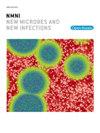饮用水输水系统中嗜肺军团菌的定量微生物风险评估:案例研究
IF 2.9
Q2 INFECTIOUS DISEASES
引用次数: 0
摘要
背景:嗜肺军团菌在医院供水系统中具有重大的健康风险。本研究评估了伊朗萨里一家医院饮用水系统一年多来与军团菌污染相关的风险。方法按季节采集医院各类水龙头的水样,包括病房淋浴和卫生间水龙头。对冷水源和暖水源进行了分析。测量了水质参数,包括pH值、氯含量和温度。采用标准微生物学技术对军团菌进行分离枚举,通过16S rRNA基因测序鉴定菌种。采用定量微生物风险评估(QMRA)模型对淋浴和水龙头的感染风险进行评估。结果温水样和夏季的沙门氏菌数量明显高于夏季。军团菌数量与水体pH呈正相关,而与氯含量和水温呈负相关。QMRA结果表明,估计的年感染风险超过了世界卫生组织(世卫组织)和美国环境保护局(美国环境保护局)规定的可接受限度,特别是在夏季。结论现有的水管理措施可能不足以控制军团菌的生长和传播。季节变化显著影响感染风险,强调需要改进监测和控制战略。然而,在解释结果时应考虑与抽样方法、地理特异性和剂量-反应模型有关的局限性。本文章由计算机程序翻译,如有差异,请以英文原文为准。
Quantitative microbial risk assessment of Legionella pneumophila in a drinking water distribution system: A case study
Background
Legionella pneumophila poses a significant health risk in hospital water systems. This study assessed the risk associated with Legionella contamination in a hospital drinking water system in Sari, Iran, over one year.
Methods
Water samples were collected seasonally from various hospital taps, including patient room showers and toilet faucets. Both cold and warm water sources were analyzed. Water quality parameters, including pH, chlorine levels, and temperature, were measured. Legionella spp. were isolated and enumerated using standard microbiological techniques, and species identification was confirmed via 16S rRNA gene sequencing. A Quantitative Microbial Risk Assessment (QMRA) model was employed to estimate the infection risk from shower and faucet use.
Results
Legionella counts were significantly higher in warm water samples and during the summer season. A positive correlation was observed between Legionella counts and water pH, whereas negative correlations were found with chlorine levels and water temperature. QMRA results indicated that the estimated annual infection risk exceeded the acceptable limits set by the World Health Organization (WHO) and the United States Environmental Protection Agency (USEPA), particularly during summer.
Conclusions
The findings suggest that existing water management practices may be inadequate for controlling Legionella growth and transmission. Seasonal variations significantly impact infection risk, emphasizing the need for improved monitoring and control strategies. However, limitations related to sampling methodology, geographic specificity, and dose-response modeling should be considered when interpreting the results.
求助全文
通过发布文献求助,成功后即可免费获取论文全文。
去求助
来源期刊

New Microbes and New Infections
Medicine-Infectious Diseases
CiteScore
10.00
自引率
2.50%
发文量
91
审稿时长
114 days
 求助内容:
求助内容: 应助结果提醒方式:
应助结果提醒方式:


